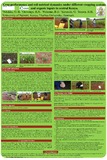| dc.description.abstract | Most soils in Kenya have been degraded and depleted of essential nutrients rendering them unsuitable
for crop production (Drinkwater et al., 1995). Prolonged application of inorganic fertilizers on the
other hand has resulted in negative environmental impacts such as accumulation of heavy metals in
soil, crop and water (Halberg et al., 2006). Intercropping systems are deliberately designed and
manipulated to optimize the use of spatial, temporal, and physical resources both above and
belowground, by maximizing positive interactions and minimizing negative ones among the
components (Silwana and Lucas, 2002). Continuous mono-cropping minus application of fertilizers
result in mining of plant nutrients and depletion soil organic matter (Lal, 2008). In the current
agricultural production environment, conventional farming methods pose the greatest risks in terms of
reduced crop yields (Keating, 2003). This coupled with the vagaries of weather that have made crop
production unreliable, hence the need for alternative means of soil fertility management.
Soil fertility depletion can be addressed through use of organic inputs and integration of legumes into
cropping systems. This will ultimately lead to increased crop yields and marketability. In view of the
ever changing weather patterns, discontent among farmers over long term field experiments and
resources required for conducting the same there is need for decision support tools to aid farmers
decision making in crop production. One such tool is APSIM model that has been tested and validated
across a wide range of environments for simulation of nutrient dynamics and crop responses to
different inputs and climate. It is thus hypothesized that, legume integration and application of organic
inputs will improve soil fertility status and enhance crop productivity. This study, therefore, aims to
determine and model crop performance and soil nutrient dynamics under different cropping systems
and organic inputs using APSIM. | |

